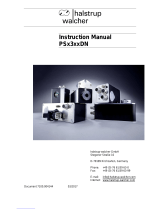
VLT® 5000/ 5000 FLUX/ 6000 HVAC/
8000 AQUA DeviceNet
Introduction to
Danfoss VLT series
and DeviceNet
Phase 1:
Is the initialization of the communication system.
During this phase the option card must respond
correctly to the VLT frequency converter initialization
command or else the VLT will not function and
display a "No Option Init" message.
Phase 2:
Is the interface watchdog function performed by
the option card as the first operational action. After
completion of this phase, data can be passed between
the VLT frequency converter and the option card
through the command channel in the dual port RAM.
Phase 3:
TheVLT frequencyconverterwill writeto the Initialization
Channel of the dual port RAM which will set the
displacement values of the various channels (Control
Channel, Status Channel, Command Channel 1,
Command Channel 2, Command Channel 3, Warning
Channel, and Spontan Channel), and the DeviceNet
option card software will read these displacements
and return a response to the VLT frequency converter
notifying that the initialization was successful or an
error was obtained in the process.
During operation (after initialization) the dual port RAM
interface is supervised by a watch-dog in the VLT
frequency converter. The VLT frequency converter will
be kept "alive" by cyclic writing to a channel in the dual
port RAM by the watch-dog handler of the option card.
■Network Variable Handling
The parameter access network variable is a structure
containing parameter number, data, value, and a
function code containing a read or write command.
The application program shall receive the data,
validate the data, convert the data to the format of
the VLT frequency converter, process the read or
write of the parameter, then send the information
back in an output network variable of the same
structure. This output variable would contain the
parameter number, error code information in the event
of an exception, and parameter value.
■Error Handling
The option card will stop sending a watchdog signal
to the VLT frequency converter when:
1. The node has been disconnected from the network
2. A network management tool has the
Option Card go Off-line
3. A hardware fault on the DeviceNet Option Card
PCB prevents reliable operation
By withholding the watchdog message, the VLT
frequency converter can detect a "Bus Time-out"
and enter secure, pre-defined state.
For recoverable errors such as [1] and [2] the option
card shall re-send the watchdog message when
the fault or condition has disappeared such as after
re-connection of the node to the network.
For unrecoverable errors such as [3] the application
program shall permit logging of network errors
without resetting or restarting the microprocessor.
This will send information to a network management
tool that will allow appropriate actions to be taken.
The only way to recover from a serious error is to
re-initialize the VLT frequency converter DeviceNet
option card by cycling power.
In case of serious VLT frequency converter fault, the
DeviceNet processor shall hold the CAN chip reset,
thereby disabling any communication to the node until
the VLT frequency converter has been re-initialized.
■Overall Function
DeviceNet is a low-level network that standa
rdizes
communications between industrial devices (sensors,
limit switches) and high level devices (controllers).
The communication network can be peer to p
eer or
master/slave. DeviceNet uses CAN technology for
Media Access Control and Physical Signaling and it
supports up to 64 nodes. DeviceNet also
defines
device profiles for devices belonging to specific classes.
For other devices, a custom class must be defined in
order to make it DeviceNet com
patible. This further
enhances the interchangeability and interoperability of
the network. Each node on the network has its own
unique media access contro
lidentifier(MACID)to
distinguish it on the network. The MAC ID is stored
in the header of the message which is split into four
different message group
s. However, DeviceNet only
makes use of three message groups keeping the fourth
one for future use. If two nodes attempt to get control
ofthenetworkbussimu
ltaneously, the CAN protocol
MG.50.H4.22 - VLT is a registered Danfoss trademark
3





















